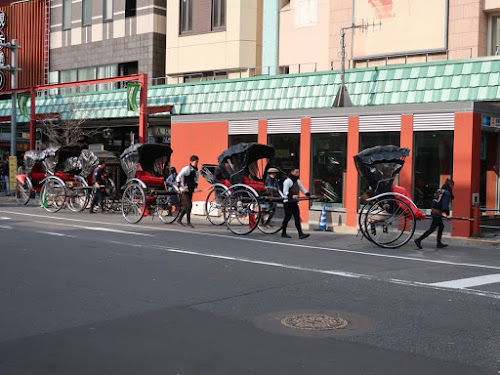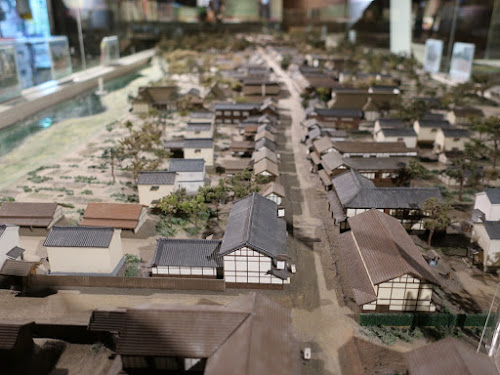Isabella's departure to northern Japan まずは日光へ
Letter 6 Kasukabe, Jun 10
Isabella hired three rickshaws and departed for
Nikko on Jun 10 with a young interpreter Mr.Ito. She wrote “The houses
were mean, poor, shabby, often even squalid, the smells were bad, and the people
looked ugly, shabby, and poor, though all were working at something or
other.” She had very bad impression concerning rural area. She stayed in Japan around
one month, but she didn’t like it. Eventually, she found the good points of the country. |
| Rickshaws in Asakusa、浅草の人力車 |
イザベラは、人力車3台を雇い、6月10日に公使館を出発し、日光に向かう。江戸を出てからも、家々はみすぼらしく、道では悪臭がし、農作業などをしている人々は醜いと述べており、来日ひと月後も、日本に好感は持っていないが、好意的な記録も残している。
She took a rest at a wayside tea house and she praised Japanese green tea. She was
born in UK which is very famous for their tea, she stated, “the infusion is a
clear straw-coloured liquid with delicious aroma and flavor, grateful and
refreshing at all time.” It must not be a high-class tea house, but the quality
of tea must be high. Green tea has been a special beverage for Japanese for a
long time.
 |
| Wayside tea house in Hakone、箱根の甘酒茶屋 |
道端の茶屋で出された日本茶は、紅茶の国イギリスから来たイザベラのお気にめして、「美味しそうな香りを持った透明な液体で、いつも心地よくリフレッシュする」と言っている。高級店ではなさそうだが、日本のお茶のレベルは高かったか。
She also mentioned tatami mats, “Japanese house-mats, tatami, are as neat,
refined, and soft a covering for the floor as the finest Axminster carpet.” Most
of Japanese love the feel of tatami and like to lay down on them.
 |
| Tatami room @ Mitsukaido Museum : Sakano’s house 水海道風土博物館:坂野家住宅 |
また、畳についても、小奇麗で洗練されソフトであり、英国のブランド絨毯と同じようだと気に入っている。
First stay at Japanese inn
She stayed at an inn (local hotel) in Kasukabe
where was a post town in the Edo period. The rooms were all full
and it was very noisy. She wrote, “On one side a man recited Buddhist prayers in
a high key, on the other a girl was twanging a samisen, a species of guitar,
the house were full of talking and splashing, drums and tom-toms were beaten
outside; --- the whistling of the blind shampooers (masseur)”. It was intolerable for her and she
complained that her privacy was invaded.
The rooms of Japanese inns didn’t have wall as partition,
they just had sliding screen made of paper, so you could hear the neighbor’s sounds
very easily. It was so bad because there were holes in the shoji screens.
Interestingly
enough, she carried a portable bed and bath tub, and she used them in the
tatami mat room. Moreover, many fleas bothered her. I respect
her to have stayed at such an inn. By the way, I guess the people who stayed at
the inn were so excited because traveling was a big event and the greatest pleasure
for them. (reference: The
history of travel of Japanese ordinary people )
 |
Japanese style room with paper sliding
doors
|
 |
| Samisen guitar player、北村姉妹・姉の演奏 |
 |
Kasukabe
post town around 1800 to 1850
|
はじめての宿の様子を記しているが、満室で大変賑やかだったようだ。按摩が来る、念仏を唱えている人が居る、三味線を弾いている人が居る、外では太鼓をたたいている人もいるし、按摩も笛を吹いて歩いているし、火の用心も来る。宿場の夜は賑やかだったようだ。イザベルには耐えられなかったようだが。プライバシーがないこともなげいているが、襖や穴のあいた障子だけで仕切られている日本の宿に泊まるのだから大したものだ。
Letter 6 (Continued)
She left
Kasukabe and went to Nikko. On the way, she saw the richer farmhouse and wrote “the
richer farmers seclude their dwellings by closely-clipped hedges”. Moreover,
she enjoyed the way, “the colossal avenue of cryptomeria which overshadows the
way to scared shrine of Nikko, and tremulous sunbeams and shadows flecked the
grass, I felt Japan was beautiful,
and that the mud flats of Yedo were only ugly dream!” |
| Big farmhouse @ Mitsukaido
Museum : Sakano’s house 坂野家住宅 Closely-clipped hedges near my house、近所の公園の生け垣(5月) |
 |
Avenue
of cryptomeria and rickshaw、日光杉並木街道と人力車
http://dl.ndl.go.jp/info:ndljp/pid/762376/234、日本写真帖から
|
Previous
post (Arriving at Yokohama, then visiting Asakusa):
Next
post (Comfortable days in Nikko):


Comments
Post a Comment